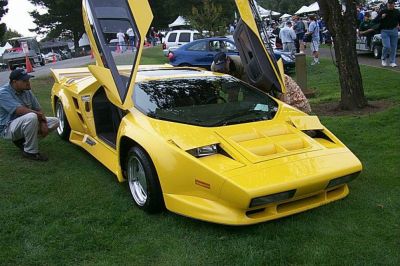 1987 Ferrari F40 Dimensions, Size & Specs
1987 Ferrari F40 Dimensions, Size & SpecsMeasurements of the 1987 Ferrari F40, engineered for optimal performance and comfort
| Dimensions | |
|---|---|
| Length: | 4358 mm171.6 in14.3 ft |
| Width: | 1970 mm77.6 in6.5 ft |
| Height: | 1124 mm44.3 in3.7 ft |
| Ground Clearance: | 125 mm4.9 in0.4 ft |
| Weight Specifications | |
| Curb Weight: | 1100 kg2425 lbs |
| Maximal permitted Weight: | 1400 kg3086 lbs |
| Tire Specifications | |
| Rims Sizes: | 17-inch rims:
|
| Tire Sizes: |
|
The Ferrari F40, produced between 1987 and 1992, stands as an iconic supercar that exemplifies the raw essence of automotive performance combined with striking design. This coupe measures 4,358 mm (171.5 inches) in length, 1,970 mm (77.6 inches) in width, and just 1,124 mm (44.3 inches) in height, boasting a low and aggressive stance characteristic of high-performance sports cars of its era. The vehicle weighs a notably light 1,100 kg (2,425 lbs) curb weight, with a maximum weight rating of 1,400 kg (3,086 lbs), reflecting Ferrari's dedication to weight reduction for enhanced speed and agility.
The F40's ground clearance, at 125 mm (4.9 inches), ensures sporty handling and stability, while the car rides on distinctive 17-inch rims, measuring 13J on the front and 17.8J on the rear, shod with wide tires sized 335/35 R17 at the rear and 245/40 R17 at the front. These specifications contribute significantly to the car's renowned grip and cornering capabilities.
The Ferrari F40 was engineered as a pure performance machine, combining lightweight construction, aerodynamics, and a powerful twin-turbo V8 engine to deliver an exhilarating driving experience. Its compact yet aggressive dimensions set a benchmark in the supercar segment during the late 1980s and early 1990s, maintaining a legacy that continues to captivate automotive enthusiasts worldwide.
Discover the standout features that make the 1987 Ferrari F40 a leader in its class
Have a question? Please check our knowledgebase first.
The Ferrari F40, produced from 1987 to 1992, is a remarkably compact yet aggressive supercar in terms of its exterior dimensions. It measures 4358 mm (171.5 inches) in length, which translates to a relatively short footprint compared to many modern supercars, emphasizing its nimble and aerodynamic design. The vehicle's width is substantial at 1970 mm (77.6 inches), giving it a wide stance that enhances stability and road grip during high-speed maneuvers. Height-wise, the F40 stands at just 1124 mm (44.3 inches), making it very low to the ground, which reduces aerodynamic drag and improves overall performance. These dimensions together contribute to the F40's iconic silhouette — low, wide, and compact, engineered for speed and agility.
The Ferrari F40 features a ground clearance (ride height) of 125 mm (approximately 4.9 inches). This low ride height is typical for performance-oriented supercars, including the F40, as it helps lower the center of gravity, improving handling characteristics, cornering stability, and aerodynamic efficiency at high speeds. However, the low clearance can pose practical challenges for everyday usability — it makes parking on uneven surfaces, navigating steep driveways, or driving over speed bumps more difficult without risking undercarriage damage. Owners typically need to exercise caution in such situations, as the car is designed more for the track or smooth road conditions than for rough or urban terrain.
Yes, the Ferrari F40 can generally fit into a standard residential garage, but with some considerations. With a length of 4358 mm (171.5 inches) and a width of 1970 mm (77.6 inches), the F40 is wider and lower than an average family car but still falls within typical garage width and length limits. The key factor to consider is the width, including mirrors, and the car's very low height of 1124 mm (44.3 inches), which does not pose a door height issue but demands care for ramps or garage floor unevenness. Since many garages are about 2.4 to 3 meters wide (94 to 118 inches), careful maneuvering is required due to the F40's width, especially with wider tires. Additionally, the garage door height usually isn't a problem because the car is very low, but care must be taken when entering or exiting to avoid scratches or damage.
The Ferrari F40 has a curb weight of approximately 1100 kg (2425 lbs), which is notably light for a supercar from the late 1980s and early 1990s. This low weight was achieved through the extensive use of lightweight materials like carbon fiber, Kevlar, and aluminum, coupled with a stripped-down, driver-focused interior lacking typical luxury amenities. Compared to other contemporaries, such as the Porsche 959 (around 1450 kg / 3196 lbs) or the Lamborghini Countach (around 1520 kg / 3349 lbs), the F40 is significantly lighter. This reduced weight contributes directly to better acceleration, handling agility, and braking performance. The lightweight design also underlines Ferrari's philosophy with the F40 — an uncompromised, pure performance machine prioritizing speed and driver engagement over comfort.
Though exact factory weight distribution figures for the Ferrari F40 vary slightly in sources, the car features a mid-engine layout, placing the twin-turbocharged V8 engine just behind the driver. This configuration results in a near-ideal front-to-rear weight balance, generally around 42% front and 58% rear. This rear-biased weight distribution enhances traction, particularly during acceleration, since more weight over the driven rear wheels improves grip. It also contributes to the car’s agility and superb handling characteristics, especially through high-speed corners. The lightweight chassis combined with this balance delivers a responsive, sharp steering feel and confident road behavior, making the F40 a driver-centric experience. However, the rear-engine bias means drivers need skill to manage oversteer tendencies at the limit.
The Ferrari F40 evolved directly from the 288 GTO, and while similar in design philosophy and performance goals, the F40 is slightly larger and more extreme in its dimensions and engineering. The 288 GTO measures approximately 4290 mm (168.9 inches) in length, while the F40 is longer at 4358 mm (171.5 inches), providing a bit more space for aerodynamic enhancements and the larger engine bay. Both models share a similar width, with the F40 at 1970 mm (77.6 inches), slightly wider than the 288 GTO. In height, the F40 is lower at 1124 mm (44.3 inches) compared to the 288 GTO's roughly 1120-1140 mm, emphasizing a sleeker, more aggressive stance. The F40 is also lighter, owing to more advanced composite materials and a stripped-down interior. Overall, the F40's dimensions reflect a refinement and increase in performance capability over its predecessor while maintaining a compact supercar profile.
When compared to other iconic supercars of the late 1980s, such as the Porsche 959, Lamborghini Countach, and Jaguar XJ220, the Ferrari F40 distinguishes itself by a combination of relatively compact dimensions and an exceptionally low weight. While the Porsche 959 was slightly heavier at around 1450 kg (3196 lbs) and the Countach even heavier at approximately 1520 kg (3349 lbs), the F40's weight of 1100 kg (2425 lbs) made it one of the lightest in its class. Dimensionally, the F40 is shorter in length than many rivals but notably wider than some, providing a planted handling feel. Its height is also lower, contributing to aerodynamic efficiency. This combination of lightness with a wide, low stance made the F40 uniquely agile and quick, solidifying its reputation as a driver-focused, uncompromising supercar in a field often defined by size and power.
The Ferrari F40 features staggered tire and rim sizes designed for optimized traction and handling balance. At the front, the car uses 13J x 17 rims fitted with 245/40 R17 tires, while the rear features wider 8J x 17 rims with massive 335/35 R17 tires. This staggered setup means the rear tires are both wider and have a slightly lower profile compared to the front, which improves rear traction especially during acceleration and cornering under rear-biased power delivery. The wide rear tires contribute to exceptional grip and stability, preventing wheel spin despite the F40’s aggressive 478 horsepower twin-turbo V8. These specialized sizes also help manage the car’s weight distribution and support its aerodynamic downforce. However, the wide tires necessitate attention when driving on wet or slippery surfaces and require high-performance tire maintenance.
The Ferrari F40’s interior is extremely minimalistic and compact, reflecting its focus on weight reduction and driver engagement rather than comfort or luxury. The cabin is tight and snug, designed primarily for driver control and feedback, with little room for large occupants. Headroom and legroom are limited due to the car’s very low height (1124 mm or 44.3 inches), and visibility is somewhat restricted due to its aerodynamic styling and rear engine placement. Unlike typical sports cars that balance comfort and performance, the F40’s cockpit strips out nearly all luxury features — no carpeting, soundproofing, or advanced electronics — to save weight. This contributes to a raw driving experience but means the interior space is minimal and quite specialized, suitable mainly for exhilarating drives rather than daily comfort.
The compact and low dimensions of the Ferrari F40 were integral to its aerodynamic efficiency and outstanding performance. Its length of 4358 mm (171.5 inches), combined with a width of 1970 mm (77.6 inches) and an extremely low height of 1124 mm (44.3 inches), created a sleek profile that minimized air resistance and enhanced downforce. The wide stance helped with stability at high speeds, while the low height reduced frontal area and drag. Additionally, the F40’s bodywork included functional aerodynamic elements like a large rear wing, NACA ducts, and vented panels that worked with its dimensions to maximize air flow, cooling, and grip. These design elements, supported by the precise dimensions, allowed the F40 to achieve a top speed of around 324 km/h (201 mph) and deliver an exhilarating driving experience, establishing it as one of the quickest and most aerodynamic supercars of its era.
Discover similar sized cars.

| Production: | 1989-1993 |
|---|---|
| Model Year: | 1990 |
| Length: | 4370 mm172.0 in |
| Width: | 1930 mm76.0 in |
| Height: | 1080 mm42.5 in |
